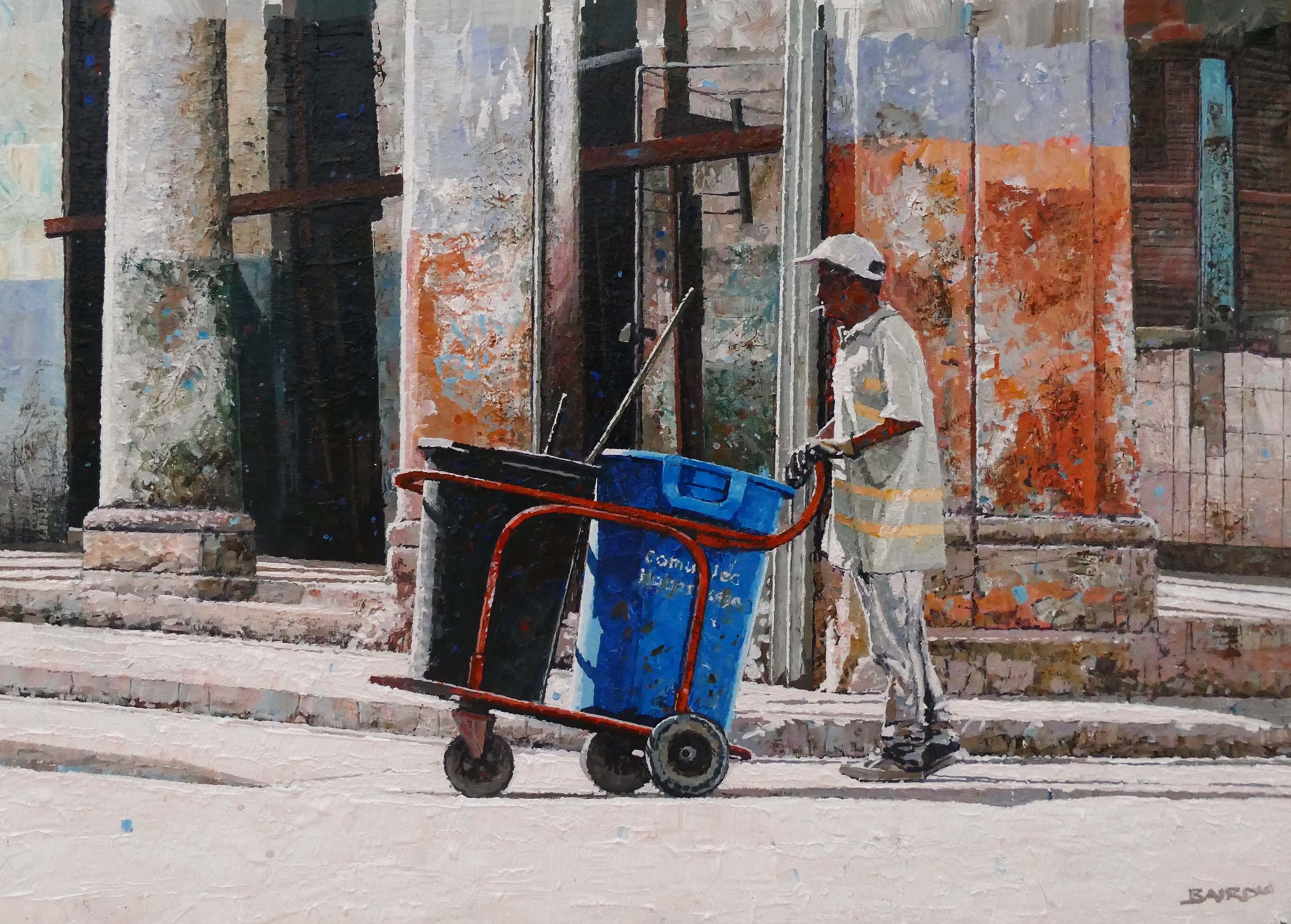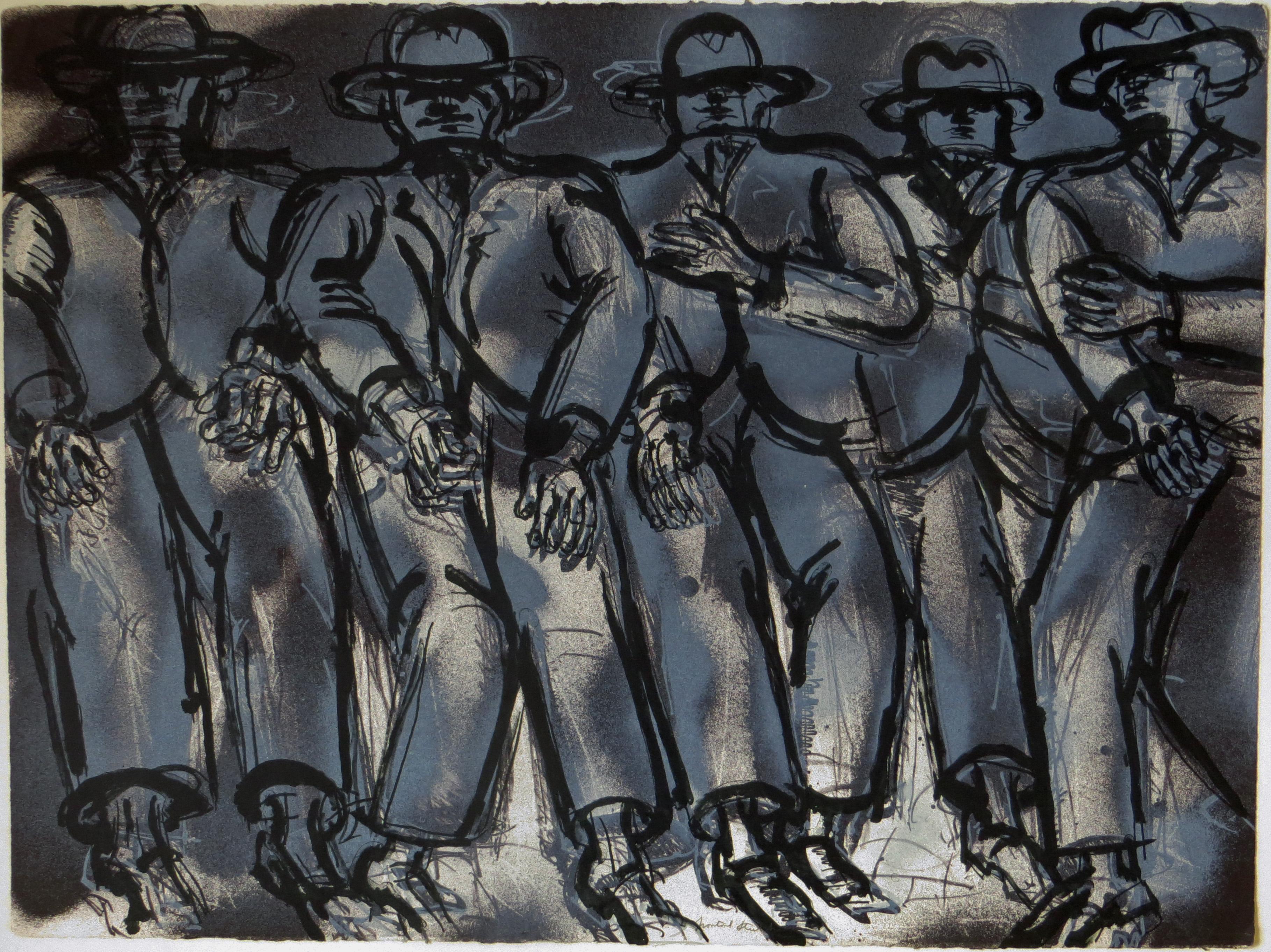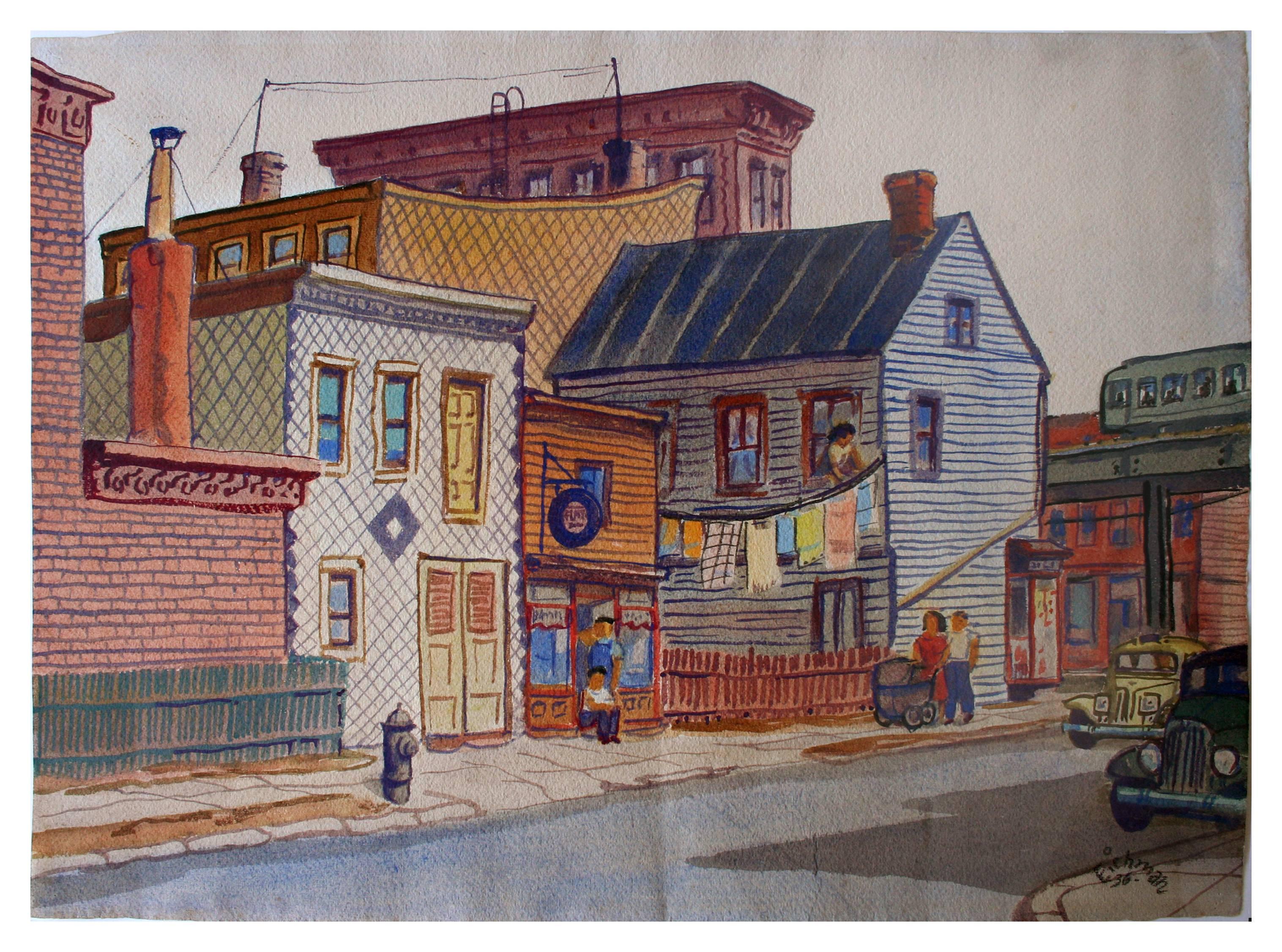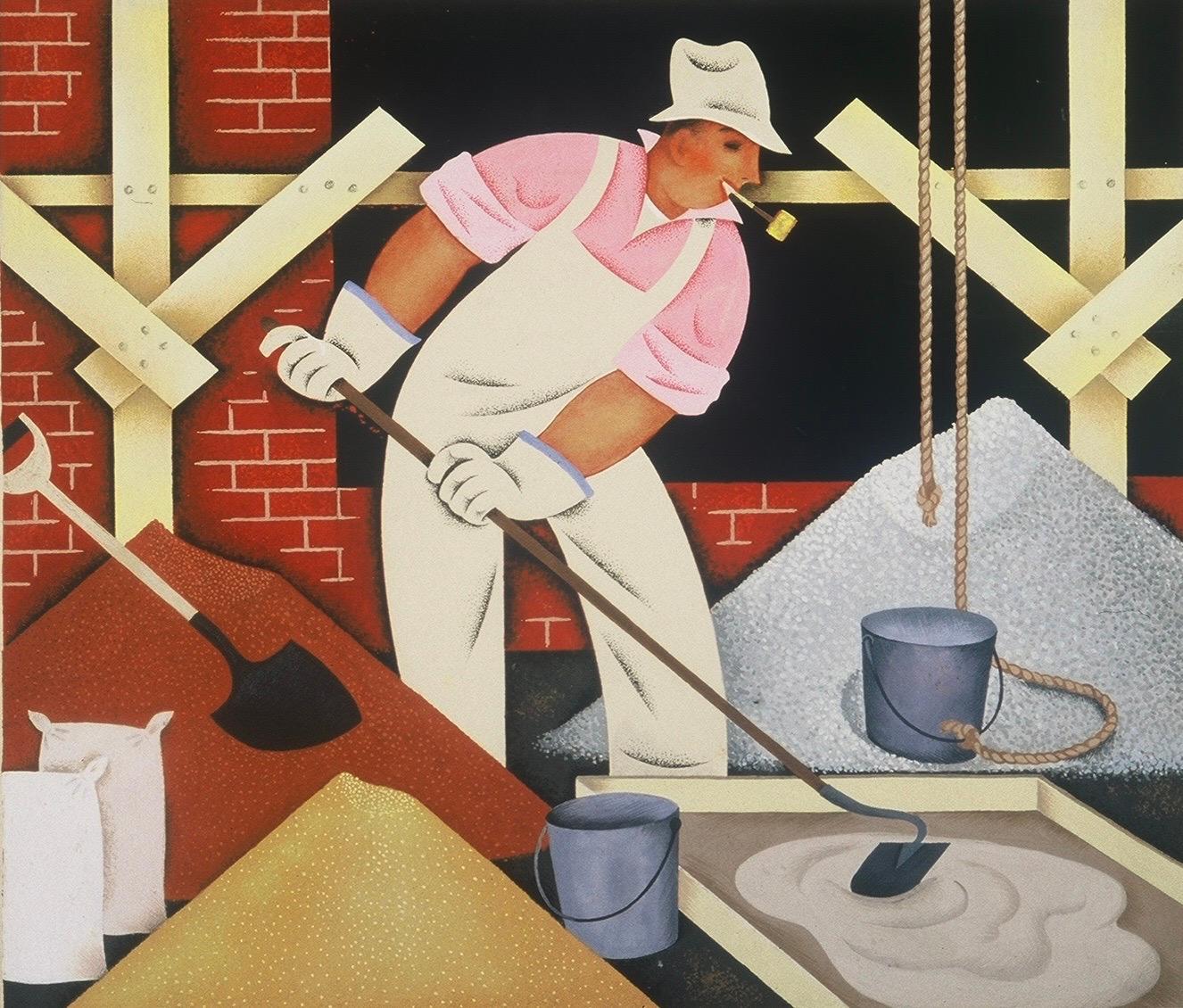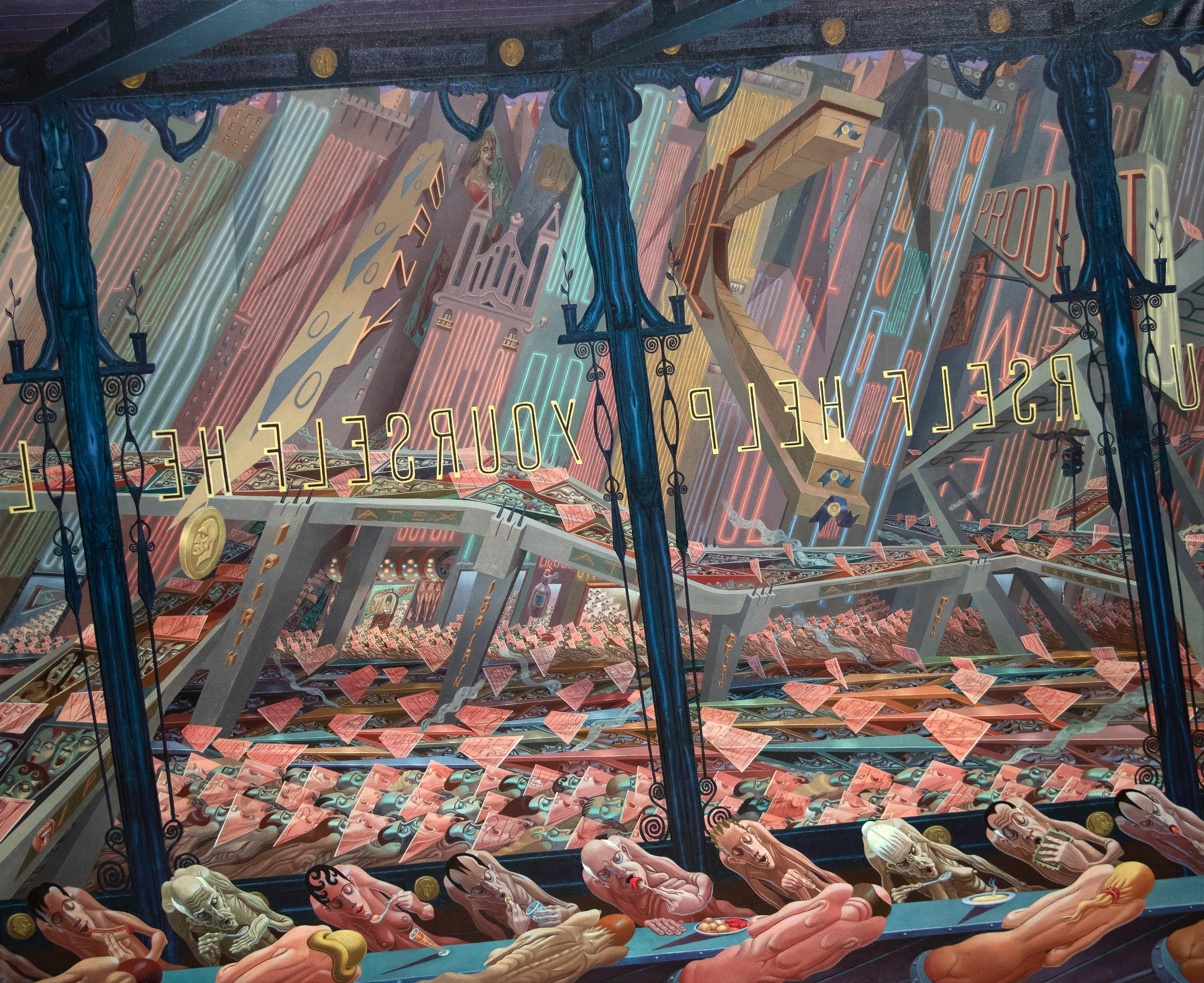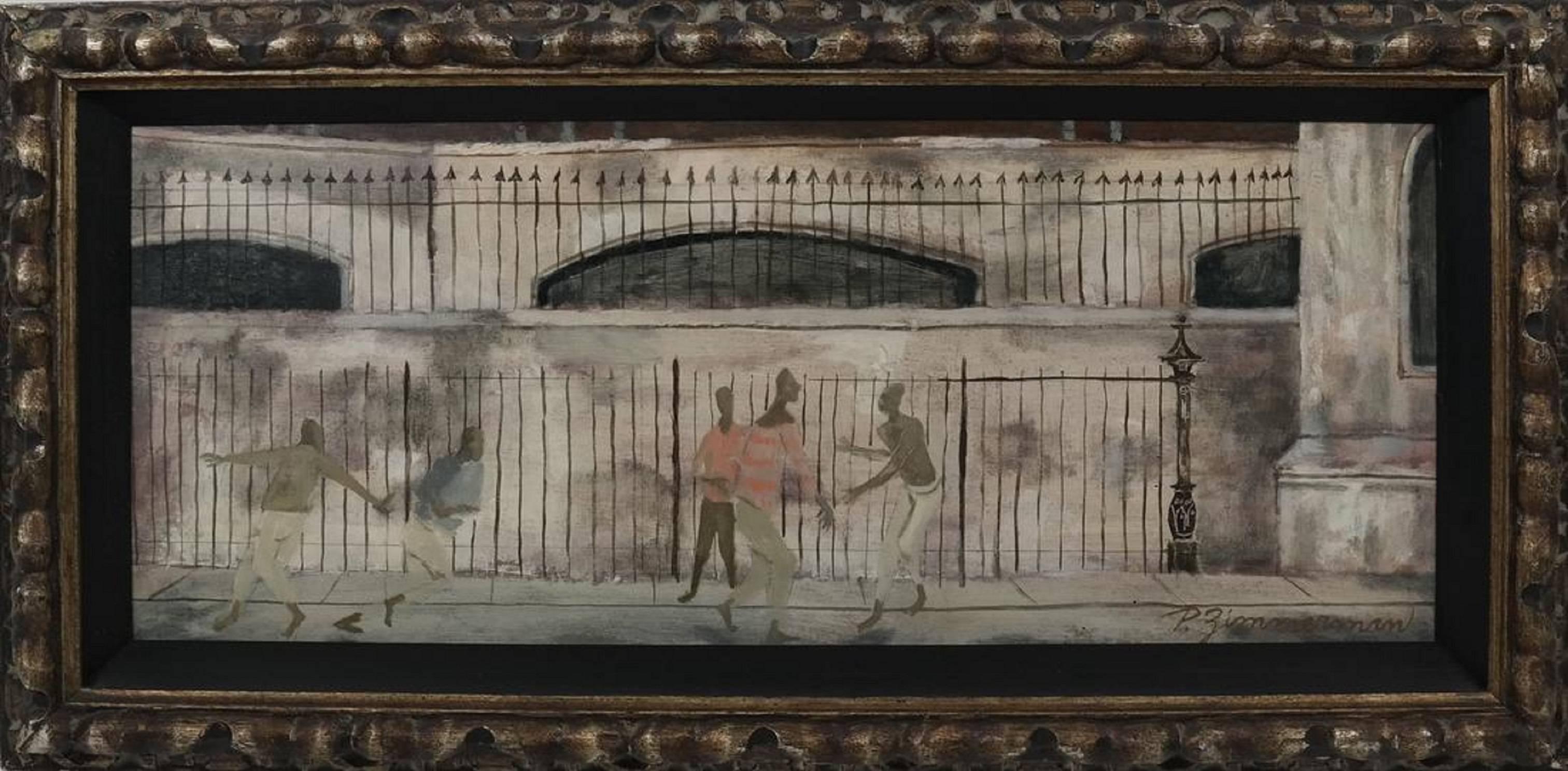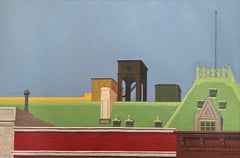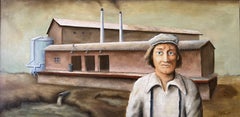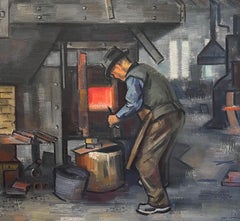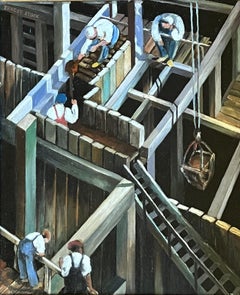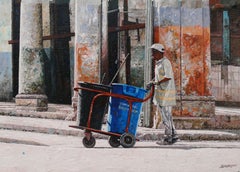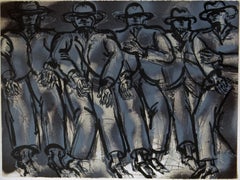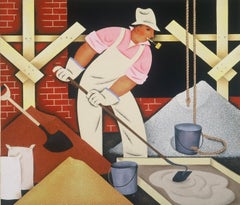Items Similar to Street Cleaners
Want more images or videos?
Request additional images or videos from the seller
1 of 5
Edward BibermanStreet Cleanersc. 1940s
c. 1940s
$45,000
£34,375.57
€39,497.45
CA$64,340.33
A$70,888.05
CHF 36,695.95
MX$853,510.50
NOK 464,659.47
SEK 436,518.18
DKK 294,898.32
About the Item
This painting is part of our exhibition America Coast to Coast: Artists of the 1930s
Street Cleaners, c. 1940s, oil on canvas, signed lower right, 28 ¾ x 42 inches, Gallery Z labels verso; exhibited in When Artists Became Workers: The People’s Art Movement of the ‘30s & ‘40s, Works by Jewish Artists in California Collections, Judah L. Magnes Museum, University of California, Berkeley, December 8, 1996 to March 30, 1997 (listed in catalog); illustrated (film) Kaufman, Jeffrey, Brush with Life: The Art of Being Edward Biberman, 2007, (DVD release 2010), 85 minutes
Price On Request
About the Painting
Street Cleaners is a light-hearted, but thoughtful, American Scene painting by Edward Biberman. In many cases, Biberman’s optimism was reserved for his sun-drenched architectural paintings of Southern California, while his figural works were often hard-hitting in-your-face compositions addressing fundamental questions of human rights. This work mediates between the two extremes. In Street Cleaners, we see a group of Black laborers smiling and laughing as an older White man, presumably their supervisor, stands by looking displeased. It appears that the workers are sharing a story or a joke at the expense of their boss. Biberman turns the tables on the conventional 1940s view of race. Here, the workers are not in the minority. Rather, they are the majority, and the White supervisor is the odd man out. Biberman was a progressive, left leaning, and socially conscious artist, who portrayed the Black community with dignity and respect. Throughout his career, Biberman was fascinated with Labor. Whether depicting a Hollywood studio strike, a Labor Day parade, the construction of a building, or the brutality of labor suppression, Biberman conveys the humanity of his workers through careful and disciplined drawing and unique coloration.
About the Artist
Edward Biberman was born in Philadelphia, the son of Ukrainian Jewish immigrants. His artistic career started at the Pennsylvania Academy of Fine Arts followed by three years of study in Paris, where he associated closely with Calder and Noguchi and exhibited at the Salon d'Automne, Grand Palais, in 1927 and the Salon des Independents in 1929. Upon his return to the United States, Biberman spent time in New York City, where he showed at many of the city’s premier galleries and museums. His works were selected for several of the Museum of Modern Art’s early exhibitions of American artists, including 46 Painters and Sculptors Under the Age of 35 (1930) and Murals by American Painters and Photographers (1932). Hoping to escape the pressures of the New York art world, Biberman moved to Los Angeles in 1936 where he could be close to his family, including his film director brother, Herbert Biberman, and his sister-in-law, the Academy Award winning actress, Gale Sondergaard.
During the course of his long career, Biberman showed at the Salon d’Automne (Paris); Whitney Museum; Metropolitan Museum of Art, Museum of Modern Art, Corcoran Gallery, Los Angeles County Museum of Art (LACMA) and dozens of other museums and galleries across the US and in Europe. Biberman completed three murals for public works projects, including his work Abbot Kinney and the Story of Venice for the Venice Post Office, which was installed for six months at LACMA in 2014. His works are in the permanent collections of more than a dozen museums, including the National Portrait Gallery (of the Smithsonian Institution), Los Angeles County Museum of Art, Museum of Fine Arts, Houston, Butler Institute of American Art, and Pennsylvania Academy of Fine Arts. Several books are dedicated to Biberman’s art, as is a feature length documentary, Brush with Life: The Art of Being Edward Biberman (2007). Biberman’s art has undergone a resurgence of popularity during the past fifteen years with four solo or focused exhibitions, Edward Biberman Revisited (2009), Edward Biberman (2011-12), Lost Horizons: Mural Dreams of Edward Biberman (2014) and Edward Biberman, Abbot Kinney and the Story of Venice (2014), and representation in a number of other exhibitions, such as To Make a World: George Ault and 1940s America at the Smithsonian Institution and other institutions (2011), Pacific Standard Time (2012), Contraption: Rediscovering California Jewish Artists (2018),Black American Portraits (2021) at LACMA, Encounters in American Realism (2022) at The Westmoreland Museum of American Art and Art for the People WPA Paintings from the Dijkstra Collection (2023) at the Crocker Art Museum (Sacramento, CA), Oceanside Museum o f Art (Oceanside, CA) and The Huntington Library, Art Museum and Botanical Gardens (San Marino, CA).
Biberman’s brand of modernism can fairly be divided into four categories 1) precisionist urban scenes of New York and Southern California which celebrate the creations of humanity; 2) portraits which expose not only the historical context, but also the souls, of his subjects; 3) rural landscapes and still life paintings which portray the beauty of America and its flora; and 4) social realist works which explore the struggles, hopes and shortcomings of our society. Regardless of genre, Biberman had a unique sense of structure and color. His figures are at the same time specific and universal. Taken as a whole, Biberman’s body of work presents the viewer with a compelling and often daring vision of 20th century America and its art.
- Creator:Edward Biberman (1904 - 1986)
- Creation Year:c. 1940s
- Dimensions:Height: 28.75 in (73.03 cm)Width: 32 in (81.28 cm)Depth: 2 in (5.08 cm)
- Medium:
- Movement & Style:
- Period:
- Condition:
- Gallery Location:Los Angeles, CA
- Reference Number:1stDibs: LU1859213055402
About the Seller
5.0
Gold Seller
Premium sellers maintaining a 4.3+ rating and 24-hour response times
1stDibs seller since 2022
17 sales on 1stDibs
Typical response time: <1 hour
- ShippingRetrieving quote...Shipping from: Los Angeles, CA
- Return Policy
Authenticity Guarantee
In the unlikely event there’s an issue with an item’s authenticity, contact us within 1 year for a full refund. DetailsMoney-Back Guarantee
If your item is not as described, is damaged in transit, or does not arrive, contact us within 7 days for a full refund. Details24-Hour Cancellation
You have a 24-hour grace period in which to reconsider your purchase, with no questions asked.Vetted Professional Sellers
Our world-class sellers must adhere to strict standards for service and quality, maintaining the integrity of our listings.Price-Match Guarantee
If you find that a seller listed the same item for a lower price elsewhere, we’ll match it.Trusted Global Delivery
Our best-in-class carrier network provides specialized shipping options worldwide, including custom delivery.More From This Seller
View AllThe Railway Station
Located in Los Angeles, CA
The Railway Station, c. 1934, oil on canvas, signed lower right, titled verso and noted "34"; illustrated Kaufman, Jeffrey, Brush with Life: The Art of Being Edward Biberman...
Category
1930s American Modern Landscape Paintings
Materials
Oil
Factory Worker
Located in Los Angeles, CA
This painting is part of our exhibition America Coast to Coast: Artists of the 1930s
Factory Worker, c. 1936, oil on canvas, signed lower right, 18 ¼ x 36 inches; exhibited in City ...
Category
1930s American Realist Figurative Paintings
Materials
Oil
Blacksmith (Untitled)
By Erle Loran
Located in Los Angeles, CA
Blacksmith (Untitled), 1936, oil on canvas, signed and dated lower right, 28 x 30 inches
Erle Loran was an influential American painter, art historian, and educator, renowned for h...
Category
1930s American Modern Figurative Paintings
Materials
Canvas, Oil
Subway Construction
Located in Los Angeles, CA
This painting is part of our exhibition American Coast to Coast: Artists of the 1930s
Subway Construction, c. 1928, oil on board, 19 x 15 ¾ inches, signed upper left, artist and title verso; exhibited: 1) 12th Annual Exhibition of the Society of Independent Artists, The Waldorf Astoria, New York NY, from March 9 to April 1, 1928, no. 864 (original price $250) (see Death Prevailing Theme of Artists in Weird Exhibits, The Gazette (Montreal, Quebec, Canada), March 8, 1928); 2) Boston Tercentenary Exhibition Fine Arts and Crafts Exhibition, Horticultural Hall, Boston MA, July, 1930, no. 108 (honorable mention - noted verso); 3) 38th Annual Exhibition of American Art, Cincinnati Art Museum, Cincinnati, OH, June, 1931 (see Alexander, Mary, The Week in Art Circles, The Cincinnati Enquirer, June 7, 1931); and 4) National Art Week Exhibition [Group Show], Montross Gallery, New York, New York, December, 1940 (see Devree, Howard, Brief Comment on Some Recently Opened Exhibitions in the Galleries, The New York Times, December 1, 1940)
About the Painting
Ernest Stock’s Subway Construction depicts the excavation of New York’s 8th Avenue line, which was the first completed section of the city-operated Independent Subway System (IND). The groundbreaking ceremony was in 1925, but the line did not open until 1932, placing Stock’s painting in the middle of the construction effort. The 8th Avenue line was primarily constructed using the “cut and cover” method in which the streets above the line were dug up, infrastructure was built from the surface level down, the resulting holes were filled, and the streets reconstructed. While many artists of the 1920s were fascinated with the upward thrust of New York’s exploding skyline as architects and developers sought to erect ever higher buildings, Stock turned his attention to the engineering marvels which were taking place below ground. In Subway Construction, Stock depicts workers removing the earth beneath the street and building scaffolding and other support structures to allow concrete to be poured. Light and shadow fall across the x-shaped grid pattern formed by the wooden beams and planks. It is no surprise that critics reviewing the painting commented on Stock’s use of an “interesting pattern” to form a painting that is “clever and well designed.”
About the Artist
Ernest Richard Stock was an award-winning painter, print maker, muralist, and commercial artist. He was born in Bristol, England and was educated at the prestigious Bristol Grammar School. During World War I, Stock joined the British Royal Air Flying Corps in Canada and served in France as a pilot where he was wounded. After the war, he immigrated to the United States and joined the firm of Mack, Jenny, and Tyler, where he further honed his architectural and decorative painting skills. During the 1920s, Stock often traveled back and forth between the US and Europe. He was twice married, including to the American author, Katherine Anne Porter. Starting in the mid-1920s, Stock began to exhibit his artwork professionally, including at London’s Beaux Arts Gallery, the Society of Independent Artists, the Salons of America, the Cincinnati Art Museum, the Whitney Studio and various locations in the Northeast. Critics often praised the strong design sensibility in Stock’s paintings. Stock was a commercial illustrator for a handful of published books and during World War II, he worked in the Stratford Connecticut...
Category
1920s American Modern Figurative Paintings
Materials
Oil
A Laborer Resting
By Robert Gilbert
Located in Los Angeles, CA
A Laborer Resting, 1930, oil on canvas, signed and dated lower center, 36 x 30 inches, inscribed verso “July – 1930 / Title – A Laborer Resting / Artist – Robert Gilbert / Price - $2...
Category
1930s American Modern Figurative Paintings
Materials
Canvas, Oil
Quarry Workers
Located in Los Angeles, CA
This painting is part of our exhibition America Coast to Coast: Artists of the 1930s
Quarry Workers, c. 1930s, mixed media on board, unsigned, 24 x 24 inches, possibly exhibited at...
Category
1930s American Modern Figurative Paintings
Materials
Mixed Media
You May Also Like
Dwight Baird 'City Work' 2018- Acrylic- Signed
By Dwight Baird
Located in Brooklyn, NY
Havana, Cuba - There is nothing glamourous about the work that keeps a city clean. And keeping a city like Havana clean is a pretty monumental task. There are a lot of piles of garba...
Category
2010s Contemporary Landscape Paintings
Materials
Acrylic
$1,560 Sale Price
20% Off
Frontal Street Scene
By Lester Johnson
Located in San Francisco, CA
This lithograph is immediately identifiable as the work of Lester Johnson (1919-2010) .
The print is titled “Frontal Street Scene.” It was published in 1970 by Collector’s Press. Th...
Category
1970s Expressionist Figurative Prints
Materials
Lithograph
Society of Six Street Scene - Figurative Abstract
By Bernard Von Eichman
Located in Soquel, CA
Stunning New York City urban modernist watercolor titled "Summer Afternoon Stroll" by Society of Six artist Bernard Von Eichman (American, 1899-1990), 1...
Category
1930s American Modern Landscape Paintings
Materials
Archival Paper, Watercolor
House Beautiful Cover Proposal. American Scene Social Realism Industrial WPA
By Antonio Petruccelli
Located in New York, NY
House Beautiful Cover Proposal. American Scene Social Realism Industrial WPA
Antonio Petruccelli (1907 – 1994)
Mixing Mortar
12 1/2 X 14 3/4 inche...
Category
1930s American Modern Figurative Paintings
Materials
Gouache, Board
American Street Scene
By Irving Norman
Located in Palm Desert, CA
A painting by Irving Norman. "American Street Scene" is a macabre social surrealism city scape, oil on canvas in a bold palette of reds, blues, and yellows by artist Irving Norman. T...
Category
Mid-20th Century Post-War Figurative Paintings
Materials
Canvas, Oil
Social Realist Street Scene of Youth at Play (African American)
By Paul Zimmerman
Located in Surfside, FL
Oil on artist's board, late 20th century, signed "P. Zimmerman" lower right; [Sight: 8 1/2" x 20 1/2"; Frame: 12 1/2" x 25"]. Reminiscent of the Mid Century Social Realist and WPA wo...
Category
Mid-20th Century American Realist Figurative Paintings
Materials
Oil, Board
More Ways To Browse
San Marino Vintage
Social Realism Social Realism Art 1930s And 1940s
Jewish Portrait
Jewish Ukraine
Edward Biberman
Cafe Scene Painting
Charlie Chaplin Vintage
Blue Face Painting
Isaac Pelayo
Kibbutz Art
New Yorker Cover
Opera Singer
Picasso Oil Painting
Shaw London
Vintage Circus Performers
Dior 1955
Golden Age Of Illustration
Jazz Oil Painting
